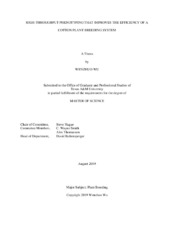| dc.description.abstract | Unmanned Aerial Vehicles (UAVs) play an important role in agricultural research because they facilitate high-throughput phenotyping (HTP). Cotton (Gossypium spp.) is the world’s leading natural textile fiber crop, and breeding programs that enhance the efficiency of growing the crop are important to the viability of the cotton industry. The effectiveness of plant breeding programs is improved when researchers have the ability to quickly evaluate important traits in a field environment. The ability to identify cotton plant height and boll count across a field can serve as an important tool in predicting plant growth and yield. In order to capture a three-dimensional (3D) view of field plots, which is believed to be helpful in estimating yield and crop development parameters, sensors mounted on UAVs must have access to a view of the ground. However, cotton planted in solid rows can obscure this view. Canopy closure prevents sensors from measuring plant architecture and boll-loads three dimensionally from the mid-growing season until the crop is defoliated. Therefore, this project was initiated to compare solid vs. skip-row planting patterns in terms of predicting yield and fiber quality since skip rows would allow UAV sensors to capture more accurate 3D data from plots. The purposes of this project were to (1) use UAVs to characterize genotype x row pattern interaction and how location and year affect that interaction, (2) evaluate the ability of UAVs to predict plant height and yield, (3) compare the accuracy of UAV-derived data from different planting patterns and (4) use images processed from UAVs to standardize data for every single row to predict yield performance. Two UAVs were used for red, green, and blue (RGB) data collection and multispectral data collection. Five cotton genotypes were grown in a skip versus solid row pattern at three locations in 2017 and 2018. Yield and fiber qualities were measured for all treatments. UAVs were flown across the field bi-weekly to estimate plant height, canopy cover, canopy volume, vegetation indices, open boll count and boll area over different growing stages. Without extreme weather influence, lint yield and fiber quality were not affected by Genotype X row-spacing effects. Also, year and location did not influence that interaction. In addition, yield and plant height estimations were improved when cotton was planted in a skip-row pattern. Single row rating based on orthomosaic images and 3D point cloud images correlated with yield performance. Therefore, to take full advantage of UAV data, cotton breeding programs need to plant early generation lines (progeny rows) in skip rows that allow sensors to have access to the view of the ground and capture 3D images. This can be accomplished without compromising the efficiency and accuracy of the breeding program. | en |


